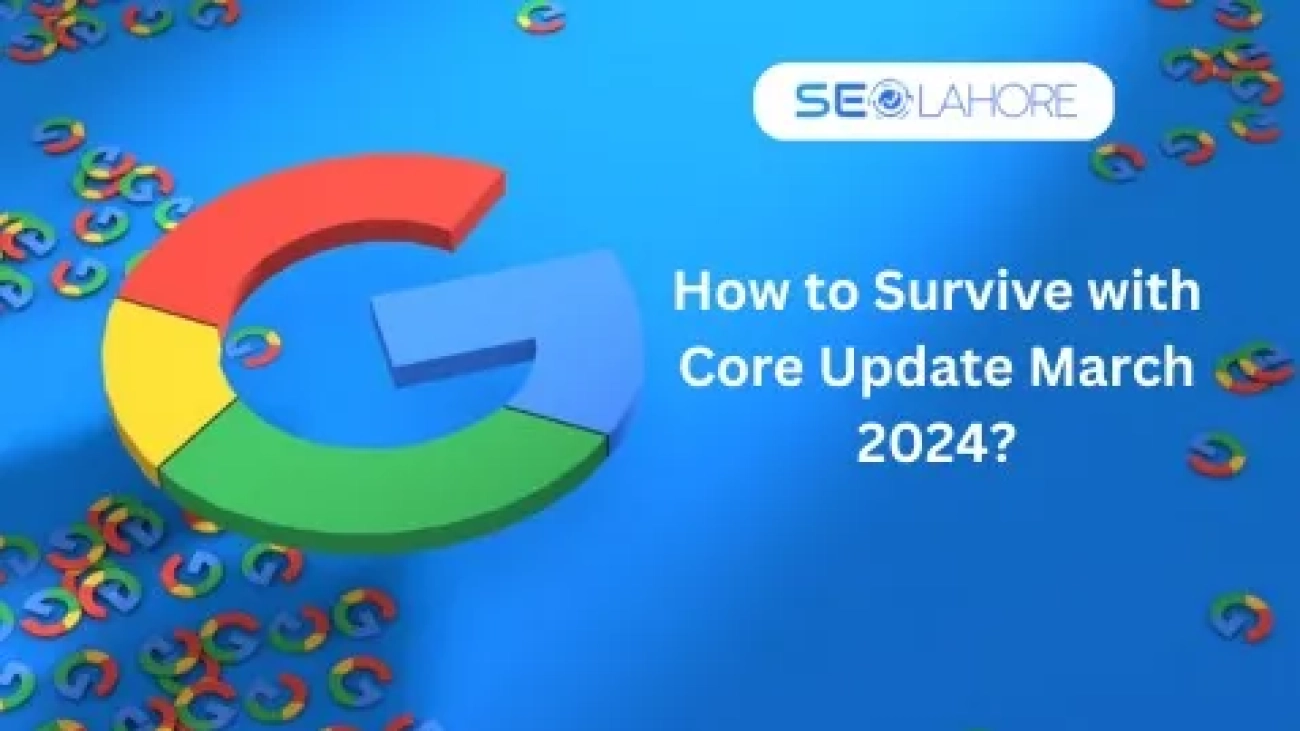Introduction
In the rapidly evolving world of online search, Google’s core upgrades are like revolutionary moments. They are influencing the digital landscape and having a significant impact on website ranking and exposure. Google improves its algorithms with each core update, strengthening the criteria for evaluating and ranking websites in search results.
Rankings and website traffic are often significantly fluctuating by these changes.
To enhance user experience and search relevance, Google released its most recent core update in March 2024. These updates are more organic as they address changing online content consumption trends and ensure accurate results.
In this article, we will discuss the complexity of the latest Google March 2024 core update, which is widely regarded as one of the most concerning issues in the digital world. So, let’s unfold the mystery of this update along with its impact on the website’s SEO.
What are Google Core Update
Google Core Updates are significant changes to its ranking algorithm, occurring once every two or three months. The basic purpose of these updates is to improve user experience by search results quality and relevancy.
Google’s core updates alter the ranking process for web pages, causing high-ranking pages to fall and low-ranking pages to gain after the update.
Purpose of Google Core Updates
➡️ Google’s primary goal with core updates is to refine and improve the search engine’s algorithms so that users obtain the most relevant and high-quality search results possible.
➡️ These updates aim to improve the overall user experience by emphasizing authoritative, trustworthy, and useful information.
➡️ Google’s algorithms are regularly updated to reflect changing user patterns, technological advancements, and developing web content trends.
➡️ One of the goals of these changes is to punish websites that engage in spamming or manipulative activity.
Finally, the goal of core updates is to ensure that users get accurate, reliable, and relevant information when they make searches, hence maintaining Google’s position as the top search engine.
History of Google Core Updates
Google core upgrades have been around since the beginning of the search engine. These updates are the upgradation of the ranking system on search engines. They mark significant turning points in Google’s continuous progress, with the goal of optimising algorithms to raise the calibre of search results. These have changed throughout time, illustrating Google’s commitment to providing people around the globe with accurate and relevant information.
Focus Points of Previous Core Updates
January 2020:
➡️ Introduced broad core algorithm update,
➡️ Increased focus on E-A-T (Expertise, Authoritativeness, Trustworthiness).
➡️ Emphasized on content quality and relevance.
May 2020:
➡️ Emphasized user experience,
➡️ Concerned for Site speed, and mobile-friendliness.
➡️ Implemented the penalty for any intrusive interstitials
December 2020:
➡️ Focused on user intent and semantic search.
➡️ Prioritized featured snippets and rich results.
June 2021:
➡️ Addressed spammy backlinks and low-quality content.
➡️ Enhanced scrutiny of affiliate content and thin pages.
July 2021:
➡️ Emphasized local SEO factors and business listings.
➡️ Enhanced relevance for localized search queries.
November 2021:
➡️ Targeted spammy structured data markup.
➡️ Imposed a fine for using misleading, irrelevant or superfluous schema markup
May 2022:
➡️ Increased emphasis on content relevancy and expertise.
➡️ Improved recognition of authoritative sources.
September 2022:
➡️ Priority was given to mobile-first indexing and usability.
➡️ Ads that are too intrusive or not mobile-friendly are penalized.
March 2023:
➡️ Addressed user-generated content quality and spam.
➡️ Focused on combating fake reviews and low-quality comments.
August 2023:
➡️ Increased focus on user engagement metrics and dwell time.
➡️ Penalty for high bounce rates and low session duration.
October 2023:
➡️ Enhanced understanding of natural language processing.
➡️ Improved comprehension of conversational queries and long-tail keywords.
November 2023:
➡️ Improved understanding of search intent and context.
➡️ Improved relevancy for detailed and precise search queries.
Google Core Updates March 2024
Google has announced the latest core update, which is supposed to have a sum up of all previous core updates with some additional points.
Google’s March 2024 update majorly emphasized on following aspects;




Highlighting the importance of unique, valuable content to maintain visibility and credibility in search results.
Is Core Updates March 2024 a Threat to Many Existing Websites
While all of Google’s core upgrades, including the latest March 2024 update, can cause swings in search ranks and traffic for some websites, they are not intended to be harmful. Rather, the goal of these updates is to make search results more relevant and high-quality, which will ultimately help both website owners and users.
As Google’s algorithms get better at identifying and penalizing such activities, websites with low-quality or irrelevant content, as well as those that employ outdated or manipulative SEO strategies, may suffer from fundamental improvements. As a result, core updates in 2024 may cause issues for some websites.
But remember these updates also provide opportunities for those who value excellent content and user experience. To get and preserve top organic search ranks on Google, now websites need to comprehend the principles underlying these latest core upgrades.
Core Update 2024 and Its Impact
Let’s categorize this latest update for better understanding.
➡️ Nature of the Update:
Combines Multiple Core Updates:
The March 2024 core update combines all previous changes to Google’s algorithms. The purpose is to improve search result relevance.
Comprehensive Approach:
Rather than offering isolated modifications, this update addresses numerous aspects of search ranking criteria together.
➡️ Addressing Concerns:
Irrelevant information Ranking High:
Before the upgrade, there was a common problem with irrelevant and low-quality information occupying prominent positions in search results.
Algorithm Manipulation:
Some content writers prioritized clickbait methods over substance, taking advantage of flaws in search algorithms to boost their rankings.
➡️ Objectives of the Update:
Improving Content Quality:
The major purpose of the March 2024 update is to improve the quality and relevancy of information appearing in search results.
Improving User Experience:
By focusing on valuable information or content, Google hopes to improve the overall user experience and credibility of its search platform.
➡️ Impact on SEO Practices:
Priority Shift:
Website owners and content writers must prioritize substance and value over cosmetic optimization strategies.
Adaptation Required:
SEO methods must fit with Google’s shifting criteria, emphasizing user-centric approaches and comprehensive content generation.
➡️ Implications for the Digital Ecosystem:
Paradigm Shift:
When it comes to SEO techniques and content generation tactics, the Google March 2024 core upgrade is the catalyst for a fundamental change in the digital game.
Emphasizes on Quality:
To be visible and credible in search results, content creators’ primary goal should be to concentrate on creating high-quality, pertinent information.
Effect on Website Reputation
The March 2024 core update introduced domain authority, enhancing website reputation and ensuring sustainability in search engine optimization.
Here’s the precise description of each point.
➡️ Introduction to Domain Authority:
Google has significantly altered its approach to website reputation. The March 2024 core update focuses on domain authority, which considers content relevance and website reliability.
➡️ Consideration of Content Relevance:
With the upgrade, Google now considers the relevance of material to a domain’s historical purpose or niche knowledge.
Websites that publish content unrelated to their defined niche may struggle to retain or improve their search rankings.
➡️ Potential Consequences for Expired Domains:
Expired domains repurposed for unrelated content can negatively impact their reputation and search visibility. These expired domains potentially make websites less trustworthy by Google’s algorithm.
➡️ Impact on SEO Strategy:
Website owners and SEO practitioners must prioritize content relevance and alignment with the domain’s existing specialization. Avoiding the usage of expired domains for unrelated content and focusing on thematic consistency within the website’s content architecture is more critical from now on.
➡️ Long-term Implications:
Domain authority highlights how crucial it is to create content that is proactive and maintains consistency across websites for establishing authority, relevance, and expertise within a particular niche.
Content Quality and Relevance
Google’s search engines always prioritize high-quality, relevant content, which improves depth and readability. They provide advice on avoiding redundancy and outmoded tactics, emphasizing the need to maintain current best practices in content production and search engine optimization.
➡️ Focus on High-Quality, Relevant Content:
Google’s unwavering commitment to providing helpful and relevant search results emphasizes the necessity of putting high-quality content first. Websites that constantly provide content that matches user intent and adds actual value are more likely to earn and keep high search rankings.
Tips for Improving Content Depth and Readability:
➡️ Tables, Graphs, and Infographics:
- Adding visual components like tables, graphs, and infographics can improve the depth and readability of text.
- Make sure the images fit the content and enhance the story by offering more background or insights into the subject matter
- In addition to breaking up text, visual aids make complex information easier to understand and retain.
➡️ Caution Against Duplicating Content or Relying on Outdated Techniques:
Copying Content:
- Google penalizes websites for duplicating information or content across several pages or from other sources. It is critical to ensure that any material on your website is unique and adds value to users.
Relying on Outdated Techniques:
- SEO approaches that were once beneficial may no longer produce positive effects and may even impair your website’s ranking. It is critical to stay updated with best practices and avoid using old strategies like keyword stuffing or link schemes.
Parasite SEO
With the release of Google’s core upgrades in 2024, there has been a significant increase in the use of parasitic SEO tactics. Parasite SEO is the use of third-party platforms, such as social media sites, forums, or high-authority websites, to fast-rank material in search engine results pages (SERPs).
However, parasite SEO has inherent risks and potential consequences despite its attraction or allure. Websites relying on third-party platforms for ranking may face unforeseen algorithm changes and lack of control, potentially compromising user experience and brand identification.
Search engines prefer original sources, therefore relying only on third-party platforms may not produce the intended results. To establish a strong online presence, you should focus on increasing the authority of your website and offering original and useful content.
Future Expectations
SEO trends remain unpredictable due to constant changes in search algorithms and user behaviours. Google’s cooperation with Reddit exemplifies cross-platform collaboration, with the potential to reshape content discovery and consumption. The cooperation focuses on adaptation and receptivity to digital developments.
Fostering participation and discourse is critical for navigating SEO because it drives innovation and adaptability in the digital environment. Accept uncertainty with curiosity and resilience, laying the groundwork for a more collaborative journey.
Key Strategies for Navigating the March 2024 Core Update
Surviving the core update, such as the one in March 2024, requires several essential strategies. You may improve your website’s long-term performance in search engine rankings and make it more resilient to algorithm upgrades by implementing the following tactics;
1. Evaluate Your Content:
Determine how the upgrade will affect the content on your website. Identify pages that have experienced losses or increases in rankings and traffic.
2. Quality Content:
Provide valuable, pertinent, and high-quality content for your intended audience. Make sure your content is comprehensive, well-researched, and serves the intended purpose of the user.
3. User Experience (UX)
Make your website’s user experience (UX) a top priority. Increase user satisfaction by improving site performance, mobile friendliness, and navigation.
4. Technical SEO
It entails optimizing your website’s technical aspects, such as crawlability, indexability, and site structure. Address any problems with broken links, duplicate content, or thin content.
5. Authority Building:
You can establish the authority of your website by obtaining backlinks from trustworthy sources within your niche.
6. Adaptability:
Keep up with changes to search engine algorithms so that you can modify your SEO approach appropriately. Observe how the industry is changing and modify your strategies as necessary.
7. Diversification:
Make use of other sources of traffic besides organic search. Increase the number of traffic sources you have. Investing in alternate channels such as social media, email marketing, or paid advertising might help you become less reliant on traffic from search engines.
8. Have patience and perseverance:
Recognise that it could take some time to recover from a core update. Continue to be persistent and patient while making adjustments and observing the outcomes.
Conclusion
In conclusion, the March 2024 core update emphasizes the importance of excellent content, user-centric techniques, and website authority in SEO. By prioritizing the above-mentioned features, employing those survival tactics and being flexible to future trends, website owners can weather algorithm changes with confidence. As we welcome unpredictability, staying updated and being adaptable can position us for long-term success in the ever-changing world of search engine optimization.








